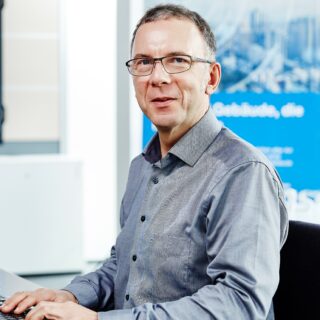
Deerns embraces a new frontier for the pharmaceutical industry by shifting mindsets.
In an era where the pharmaceutical industry is under increasing pressure to meet stringent regulatory standards while advancing sustainability goals, Deerns is stepping forward with innovative and simplified strategies. At the heart of this approach is the integration of Good Engineering Practices (GEP) – based on compliance – with sustainable design, particularly for Clean and Black Utility Systems.
" Achieving harmony between sustainability goals and strict regulatory compliance remains one of the pharmaceutical industry's most complex challenges.
The sector operates under rigorous GMP requirements designed to ensure product safety, consistency and traceability. However, these same standards can sometimes make innovation and environmentally friendly practices more difficult to implement.
Yet, within this demanding framework lies a unique opportunity: GMP’s structured approach can also serve as a foundation for embedding sustainability into system design, utility operations and facility management while ensuring compliance. Navigating this dual mandate requires a sophisticated understanding of both technical systems and the evolving expectations surrounding carbon reduction, energy efficiency and responsible resource use.
Overcoming Resistance
A significant obstacle to aligning sustainability with GMP is resistance to change – often found at every level of the project lifecycle. Clients may be hesitant to approve new technologies or systems that deviate from traditional models. Management teams may prioritise short-term capital costs over long-term efficiency. Meanwhile, contractors, vendors and other stakeholders may be unfamiliar with sustainable design alternatives or wary of adjustments that could impact timelines and compliance.
In our experience, overcoming resistance is never just about the technical solution – it’s about people. Open, transparent communication is essential to building trust and create space for dialogue.
" It is about helping stakeholders understand that sustainability isn’t a complication or a risk – it’s a long-term asset.
Once that mindset shifts, and everyone is aligned on both performance and environmental goals, the decision making becomes much smoother. That’s when sustainable design really starts to gain traction and deliver impact.
Streamlining Complexity in Critical Utility Systems
Clean and Black utilities, the infrastructure backbone of pharmaceutical facilities, are central to this conversation. Clean utilities such as Purified Water, Clean Steam and Compressed Air are used directly in manufacturing processes and HVAC for cleanrooms. Black utilities, including energy and waste systems, support the broader operations. Making these systems energy efficient and compliant without compromising GMP standards requires a careful, considered approach.
Deerns’ methodology focuses on GEP that help in simplifying complex processes by delivering compliant, practical solutions. By prioritising clarity and usability, even advanced systems become accessible for clients to implement and maintain.
The key challenges encountered in integrating GMP and Sustainability are:
- High initial costs: Sustainable technologies often demand greater upfront investment, but deliver long-term savings in energy, water and waste management.
- Conflicting global regulations: A method approved in one country might be forbidden in another, complicating the design of multinational operations.
- Data Management: Moving towards digital monitoring and reporting of sustainability targets, alongside GMP compliance, requires robust systems and expertise in extensive data management.
Deerns addresses these challenges through GEP aligned with GMP and value engineering studies, helping clients understand long-term benefits and cost recovery timelines. By explaining the time required to recover the investment versus the cost of less efficient technologies, we help clients be more open to change and embrace it. We also support our pharmaceutical clients on their data management throughout the project lifecycle including Commissioning, Qualification and Validation (CQV) support for a broader range of services.
The FIVE Benefits of a Dual Approach
The FIVE benefits of combining GMP compliance with Sustainability are substantial:
- Enhanced regulatory compliance on both quality and environmental fronts
- Reduced energy and water consumption
- Improved operational efficiency and resource utilisation
- Lower long-term operating costs
- Minimised environmental impact
These two pillars, when expertly integrated, offer a strategic path toward more resilient, efficient and future focused pharmaceutical operations. At Deerns, we achieve this through our extensive experience and knowledge combined with a highly collaborative approach. We focus on value engineering analysis to highlight savings and the advantages of proposed solutions, and we take time to build trust relationships with our most important stakeholders – our clients.
Real-World Application: Energy savings in a highly regulated environment
A notable project shows how sustainability and GMP compliance can align in practice. The initiative at Organon Oss aimed to optimise energy savings in a highly regulated environment as part of an upgrade to the HVAC system. High energy demand and operational costs made the HVAC system a prime area for improvement.
To address this, our team initially performed a pilot study in one of the buildings that included leading stakeholder workshops, researching and analysing possible energy savings. The main challenges were ongoing production, and the current complex situation both at building level and in production areas.
What made this project particularly rewarding was seeing how Good Engineering Practices and maximising communication enabled stakeholder engagement once people saw the reports and understood the benefits of achieving their carbon neutrality goals. We weren’t just proposing upgrades – we were showing how small changes could deliver measurable energy savings without compromising GMP. That shift in mindset made all the difference. The project successfully reduced energy consumption without compromising compliance, becoming a model for future efforts.
Here’s where we Think Ahead
As the pharmaceutical industry faces growing expectations to deliver both regulatory excellence and environmental responsibility, the need for integrated, forward-thinking strategies has never been greater. Deerns is proud to be at the forefront of this evolution, guiding clients through the complexities of GMP compliance while embedding sustainability as a core design principle. We innovate continuously to support our clients in reaching their carbon neutrality goals by 2030 – because we know from experience that their success will also be our success.
By simplifying the path to innovation, fostering collaboration, and demonstrating the long-term value of sustainable choices, we’re helping shape a future where high-performance facilities are also environmentally responsible.







































